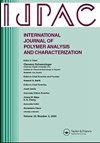Combined kinetic analysis of thermal degradation characteristics and reaction mechanism of thin intumescent fire-retardant coating of steel structure
IF 1.6
4区 工程技术
Q4 POLYMER SCIENCE
International Journal of Polymer Analysis and Characterization
Pub Date : 2024-09-11
DOI:10.1080/1023666X.2024.2399791
引用次数: 0
Abstract
To determine the thermal kinetic triplets and elucidate the reaction mechanism of thin intumescent fire-retardant coatings (IFR) of steel structures, one efficient combined kinetic approach was implemented in this study. Thermogravimetric experiments were conducted in air atmosphere at four heating rates, and the whole IFR thermal degradation process was divided into two stages. The average activation energy values derived by model-free methods were 78.9 kJ/mol and 175.16 kJ/mol for Stage I (0<α < 0.2) and Stage II (0.2<α < 0.9), respectively. Furthermore, the linear Coats-Redfern (CR) and non-linear Masterplots models were applied to identify the possible reaction mechanism. It was found that the F3/2 mechanistic model was better suited to the main thermal degradation process. Then model reconstruction based on the F3/2 mechanism model was performed. The results showed that the reconstructed model had a strict linear relationship in the independence analysis and KCE analysis, along with a good agreement between the theoretical and experimental results. The current study provided new insights into the systematic thermal degradation mechanism of IFR, and the proposed kinetic model would be helpful for the thermal protection prediction for steel structure during fire.
钢结构薄型膨胀型防火涂料热降解特性与反应机理的组合动力学分析
为了确定钢结构薄膨胀型防火涂料(IFR)的热动力学三元组并阐明其反应机理,本研究采用了一种高效的组合动力学方法。在空气中以四种加热速率进行热重实验,将整个 IFR 热降解过程分为两个阶段。在第一阶段(0<α <0.2)和第二阶段(0.2<α <0.9),无模型方法得出的平均活化能值分别为 78.9 kJ/mol 和 175.16 kJ/mol。此外,还应用线性 Coats-Redfern (CR) 模型和非线性 Masterplots 模型来确定可能的反应机理。结果发现,F3/2 机理模型更适合主要的热降解过程。然后在 F3/2 机理模型的基础上进行了模型重构。结果表明,重构后的模型在独立性分析和 KCE 分析中具有严格的线性关系,理论结果与实验结果之间具有良好的一致性。本研究为系统研究 IFR 的热降解机理提供了新的视角,所提出的动力学模型将有助于火灾期间钢结构的热保护预测。
本文章由计算机程序翻译,如有差异,请以英文原文为准。
求助全文
约1分钟内获得全文
求助全文
来源期刊
CiteScore
3.50
自引率
5.30%
发文量
37
审稿时长
1.6 months
期刊介绍:
The scope of the journal is to publish original contributions and reviews on studies, methodologies, instrumentation, and applications involving the analysis and characterization of polymers and polymeric-based materials, including synthetic polymers, blends, composites, fibers, coatings, supramolecular structures, polysaccharides, and biopolymers. The Journal will accept papers and review articles on the following topics and research areas involving fundamental and applied studies of polymer analysis and characterization:
Characterization and analysis of new and existing polymers and polymeric-based materials.
Design and evaluation of analytical instrumentation and physical testing equipment.
Determination of molecular weight, size, conformation, branching, cross-linking, chemical structure, and sequence distribution.
Using separation, spectroscopic, and scattering techniques.
Surface characterization of polymeric materials.
Measurement of solution and bulk properties and behavior of polymers.
Studies involving structure-property-processing relationships, and polymer aging.
Analysis of oligomeric materials.
Analysis of polymer additives and decomposition products.

 求助内容:
求助内容: 应助结果提醒方式:
应助结果提醒方式:


